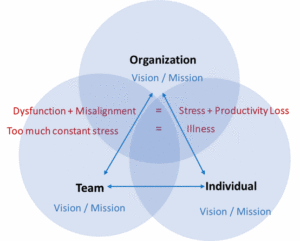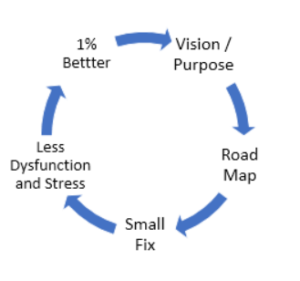
More than ever, organizations need to be able to adapt and innovate to survive and prosper.
The challenges can seem daunting with the speed of technological change and the emergence of new sources of disruptive competition. People today are experiencing more stress and emotional drain (according to Statistics Canada, over 25 % of working Canadians between 20 and 55 report being extremely stressed). This is impacting the physical and mental health of the workforce, compromising their ability to adapt and work productively in an increasingly competitive world. Healthcare costs are increasing as the prevalence of mental and physical health conditions continue to rise.
According to the US Center for Disease Control, over 75% of illness today relates to people’s response to the stress in their lives. It has a cascading detrimental impact on the body, mind and workplace as the chart below highlights.
Unmanaged Chronic Stress Erodes Your Team’s Ability to Perform:
Reduces Physical Capacity
- Weakened autoimmune response
- More Illness and pain
- Weight gain
- Heart disease
- Diabetes
- Less energy to get things done
Alters Brain Function
- Weakened neural network
- Reduced brain size
- Disrupted sleep
- less able to concentrate
- More Anxiety and depression
- Weaker social connections
Increasing Problems Hurt Results
- Impaired thinking
- Poorer decisions
- Greater distraction
- Less effective communication
- Reduced learning capacity
- Less able to perform under pressure
This has a direct impact upon people’s ability to perform well at work.
Chronic stress adversely impacts the functioning of the mind, its ability to learn, adapt to new challenge, communicate and make good decisions. For example, difficulty sleeping is a common problem for many stressed individuals. A study published by Occupational & Environmental Medicine in 2000 found moderate sleep deprivation could produce impairments in cognitive and motor performance equivalent to legally prescribed levels of alcohol intoxication. Coming to work impaired under the influence of alcohol is not acceptable in most workplaces.
Organizations are beginning to recognize and respond to the challenge with various wellness initiatives to protect the health and productivity of their workforce. While well intended, most of these initiatives fail to deliver the potential benefits promised.
The Question Is Why:
Established behaviour is hard to change. People and organizations are complex interconnected systems. There are many counteracting forces at play that pull people in different directions. Without initiatives building upon themselves they will fail to gain traction for one or more of the reasons below:
1. Choosing a solution in isolation
Most new initiatives fail to have impact because they are put in place without adequately connecting to the broader realities of the workplace in a way that builds positive reinforcing behavior loops. If you learn something new and never practice it what impact does it have?
2. Not understanding how people make decisions
People’s decisions are often emotional and not logical. They are impacted by the social norms, cues and nudges in the world around them. If you want to eat better and the office norm is a working lunch with pizza most days, what impact does the nutritional coaching session have? Programs that that don’t effectively address the realities of human behaviour and established norms in the workplace will fail to gain traction.
3. Failing to build a cohesive strategy that is aligned
To have real impact, initiatives need to be part of an adequately funded, cohesive strategy that is aligned with corporate vision, mission and goals at an individual, team and organization level (see chart). Programs and people don’t operate isolation. They impact and are influenced by the environment that they operate in. Greater alignment of individual, team and corporate initiatives over time translate into less dysfunctional behaviour, lower levels of stress and a healthier more focused workforce that can deliver better operating results.

Win by Aligning Programs and Building Organizational Resilience
The 2019 Toronto Raptors basketball season was the culmination of a 25-year journey when all Masi Uriji’s initiatives came together. Kwhai Leonard played an important part, but to win the NBA finals took vision and a complete team effort. An effort that aligned people, skills, coaching, support systems, belief and mental toughness to build the resilience necessary to win.
In the day-to-day world outside the glamour of professional sports, most of us work in some form of interdependent team environment. To perform well (like the Toronto Raptors) you need the right mix of vision, support systems, communication, and healthy, resilient team players who have the skills, mental toughness and mindset to perform well.
There is clearly a need to find better ways to respond to the challenge. Low levels of workforce engagement (2016 Gallup survey found less than 35% were engaged at work), rising prevalence of mental health concerns and increasing levels of stress are all symptoms of workplace dysfunction (friction) that are increasing costs, lowering profit and reducing the likelihood of long term survival.
Where to Start:
Let’s look at the British national cycling team. Over a period of 8 years they moved from being one of the worst to become the best cycling team in Europe by working to get 1% better each day, focusing on one priority at a time.
The organizational problems (dysfunction) contributing to stress, employee illness, higher operating costs and reduced growth potential developed over time and will take time to fix. This is a journey that should start with a clear vision and purpose.
Complete an organizational assessment that identifies your current mindset, alignment and abilities of the management team to achieve the vision (transformation) while identifying barriers that limit your ability to succeed. This will provide you a roadmap that allows the organization to adapt through a series of many small fixes over time that build upon themselves through positive feedback loops that creates a more positive environment over time.
Senior management need to be committed and involved with supportive messaging and action. Completing a mapping or assessment of the organization’s current mindset, structural gaps and organizational (people) challenges will help identify where to start with the most cost-effective initiatives having the greatest positive impact. This also lays the foundation for a more cohesive strategy with reinforcing initiatives that build upon each other.
The objective is alignment. Do you have the appropriate support systems in place so that your team can bring their best game to work each day? Start by looking at what works best for potential lessons that can be applied elsewhere in the organization, “Share the Learning”!!
Review existing benefit and other support programs to ensure they are properly aligned and support the needs of your performance team. If there are gaps, build the support needed to keep your management team healthy, resilient (able to effectively manage the stress in their lives) and connected to the workforce. This is the source of your greatest leverage in positively impacting workplace culture, reducing workplace dysfunction (stress) and improving overall performance.
The Toronto Raptors were only able to win the championship after they were able to align all the programs needed to get the best performance out of the team.

